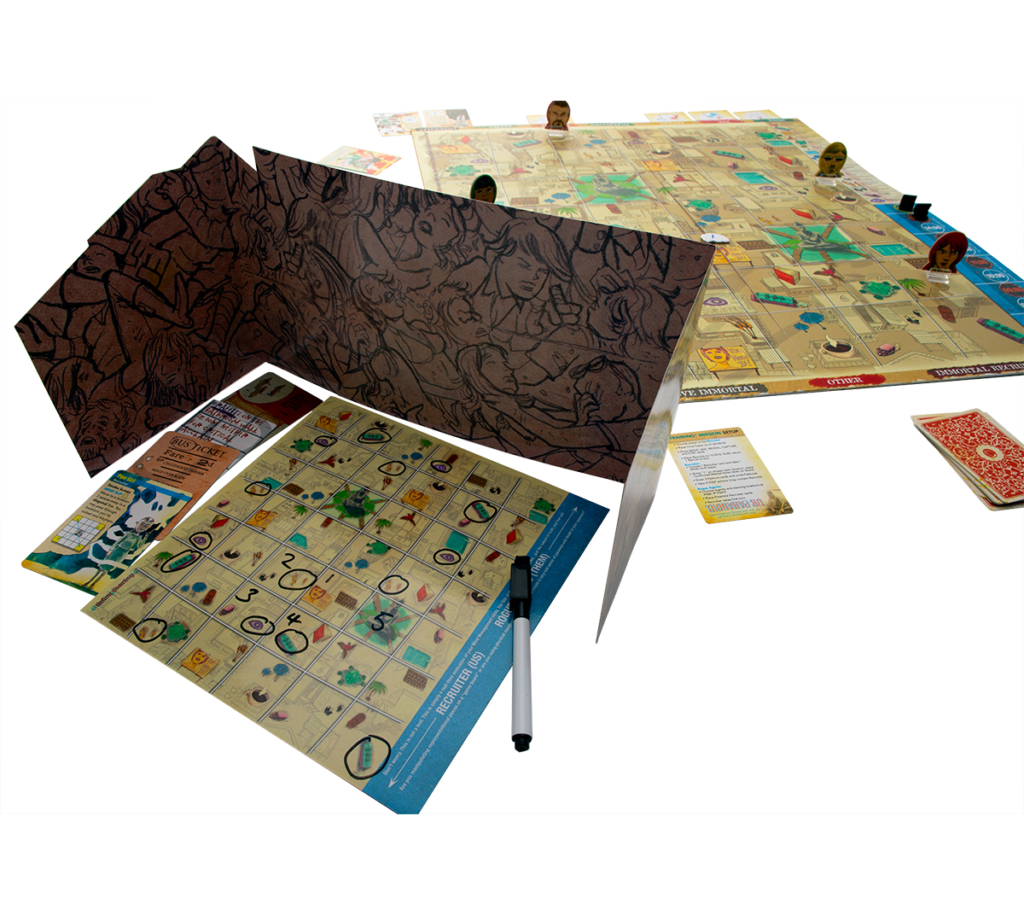
Mind MGMT is an asymmetrical hidden movement board game for 2-5 players. One player takes on the role of a psyop recruiter, secretly moving around the board and recruiting agents. All the other players are rogue agents, aiming to track down and capture the recruiter before they escape or finish their recruiting mission. Each round, the recruiter may move one space orthogonally on the 7×6 board to a tile they haven’t visited, passively recruiting agents at 3 specific locales out of 16 potential ones. Each tile has two of the sixteen, with no pair appearing more than once.
These locales, however, offer a double purpose – after the recruiter has moved, two out of the four rogue agents may move and take an action, such as asking if the recruiter has ever visited a locale in a tile they’re in. The recruiter must then choose one of the tiles they’ve been on with that locale and place a foot token there. Because these two mechanics are tied together, rogue players may realize that a certain locale is the one that the recruiter is seeking out, and plan to play around those.
Once a foot token has been placed, rogue agents can then go to that tile, and exchange the foot for a timed marker. This marker tells them at what turn exactly the recruiter was there, allowing them to build a timeline and speculate on the recruiter’s plans. Sometimes, the locales the agents ask about haven’t been visited, which can sometimes be more informative than giving a specific location. All around I think it’s a tight hidden movement game that streamlines many actions and offers different modes of play.
Variable Player Number and Experience
First and foremost, the player experience is affected by the style of game players choose. We played the short or tutorial version, which has significantly streamlined mechanics and fewer turns. While being significantly easier to teach, this gamemode offers entry points into the more complex full gamemode. For example, in the larger game, the different locales have their own guessing game built in, where the rogue agents can jump through hoops to permanently disable one of the recruiter’s recruiting locales. Another key feature of the larger game is a Shift system- a different take on the popular legacy system. The system assumes you play with the same group several times, and depending on which side has lost more, they get slight advantages, which may look like a new ability, a new character, a free move, etc. In this way, the gameplay can be adjusted from game to game without permanently altering its state, like legacy games.
Player number also affects the style of game played – all four rogue agents can be played by a single person, creating a 1 vs 1 experience akin to a chess game, where each player talks very little, instead letting their actions speak for themselves. On the other hand, having multiple players for the rogue agents allows for more creativity and communication, however, the recruiter is present and can listen to all of it. Players can use the unused time markers as notes for themselves, creating webs of possibilities on the board, however, the recruiter sees them as well. The communication introduced in these ways creates a contentious relationship between the recruiter and the rogue agents, where the recruiter may taunt the rogue agents and change their plans according to what they overhear.
There are two key game mechanics that prevent quarterbacking. (For those unfamiliar, quarterbacking is a co-op game term where one player makes all of the decisions for their team, telling others where to go and what to do, see Pandemic for a common example.) The rogue agents’ actions are staggered – each turn 2 of the active agents may be moved, then are deactivated, and every two turns they are reset, allowing for flexibility in who goes when. This gives each player a chance to make their own decisions and adapt to the new information given to them. This information is presented in straightforward ways, and strongly guides the players to mark up the board with their ideas rather than keep it in one player’s head.
Visual Theme
This review would not be complete without praising the strong visual theme and ludonarrative unison. Every component of the game has some tie-in to the psyop narrative, even down to the meeples with meeple cutouts inside them. The round counter doubles as a hidden text decoder, which is present throughout the board, cards, and even the rulebook. Some of this hidden text even allows for new rules to be found online! This offers a unique exploratory experience, and again, fits right into the psyop paranoia theme wrought into the game.
Conclusion
All around, this game impresses me with its solid gameplay and expansive opportunities. I haven’t had much opportunity to experiment with the Shifts, or even the full game, but it’s always a blast.